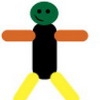Hello,
I wanted to know how do you turn a low poly model into a high poly? I did several models for a project for my job and I put all the details that I wanted while keeping the poly count low and manageable. But my employer wonders if I can make the models a higher poly count. I know the correct process is to create a high poly model and then make a low poly version, but I have no experience making a high poly model. My experience is all about making my models as efficient as possible for gaming. Namely, getting the shape and details I want using the fewest possible polygons. The models are also checked and double check to make sure they have no ngons and tris.
I know just adding more edges is not the way to making a high poly model, so I am stuck. Any advise will be helpful.









